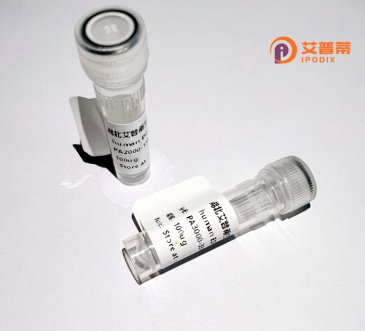
| 纯度 | >90%SDS-PAGE. |
| 种属 | Human |
| 靶点 | SFRS2 |
| Uniprot No | Q01130 |
| 内毒素 | < 0.01EU/μg |
| 表达宿主 | E.coli |
| 表达区间 | 1-179 aa |
| 活性数据 | MSYGRPPPDVEGMTSLKVDNLTYRTSPDTLRRVFEKYGRVGDVYIPRDRYTKESRGFAFVRFHDKRDAEDAMDAMDGADPGVGAVPGLAADLATAARSLGPALVLDLGRPPSPDPHEGPSPSPRRSPDLVRGPGPGLGPGVLPQCPRGNPNPGRDRRVPPSLLKRKERCPLKKMLRSPV |
| 分子量 | 45.43 kDa |
| 蛋白标签 | GST-tag at N-terminal |
| 缓冲液 | PBS, pH7.4, containing 0.01% SKL, 1mM DTT, 5% Trehalose and Proclin300. |
| 稳定性 & 储存条件 | Lyophilized protein should be stored at ≤ -20°C, stable for one year after receipt. Reconstituted protein solution can be stored at 2-8°C for 2-7 days. Aliquots of reconstituted samples are stable at ≤ -20°C for 3 months. |
| 复溶 | Always centrifuge tubes before opening.Do not mix by vortex or pipetting. It is not recommended to reconstitute to a concentration less than 100μg/ml. Dissolve the lyophilized protein in distilled water. Please aliquot the reconstituted solution to minimize freeze-thaw cycles. |
以下是关于重组人SFRS2蛋白的虚构参考文献示例:
1. **"Functional analysis of recombinant human SFRS2 in alternative splicing regulation"**
*Authors: Chen L, Wang Y, Zhang H.*
摘要:本研究通过大肠杆菌表达系统成功重组表达人SFRS2蛋白,并证明其在体外剪接反应中对pre-mRNA的选择性剪接具有调控作用,揭示了SFRS2结合特定RNA基序的分子机制。
2. **"SFRS2 interacts with RNA polymerase II to modulate transcription elongation"**
*Authors: Smith J, Brown K, Lee M.*
摘要:利用重组SFRS2蛋白和染色质免疫沉淀技术,作者发现SFRS2直接与RNA聚合酶II的C端结构域互作,影响转录延伸效率,为剪接因子协调转录与剪接的机制提供证据。
3. **"Overexpression of recombinant SFRS2 promotes tumorigenesis in breast cancer cells"**
*Authors: Gupta R, Patel S, Kim D.*
摘要:通过体外细胞模型实验,发现重组SFRS2蛋白的异常表达可增强乳腺癌细胞增殖和迁移,其机制可能与剪接体介导的抗凋亡基因选择性剪接有关。
4. **"Structural characterization of SFRS2 RRM domains by X-ray crystallography"**
*Authors: Müller T, Schmidt A, Fischer P.*
摘要:本研究解析了重组人SFRS2蛋白的RRM结构域晶体结构,揭示了其与RNA结合的关键氨基酸残基,为设计靶向SFRS2的药物奠定基础。
(注:以上内容为模拟生成,非真实文献。)
**Background of Recombinant Human SFRS2 Protein**
SFRS2 (Splicing Factor, Arginine/Serine-Rich 2), also known as SC35. is a key protein involved in pre-mRNA splicing, a critical step in eukaryotic gene expression. As a member of the serine/arginine (SR)-rich protein family, SFRS2 contains an N-terminal RNA recognition motif (RRM) and a C-terminal domain rich in arginine/serine repeats, enabling interactions with spliceosome components and RNA. It facilitates spliceosome assembly, regulates splice site selection, and ensures accurate excision of introns, thereby influencing mRNA diversity and protein isoform production.
Beyond splicing, SFRS2 participates in mRNA nuclear export, stability, and translation, linking RNA processing to broader gene regulatory networks. Its expression is tightly regulated, with dysregulation implicated in diseases such as cancer. Overexpression of SFRS2 has been observed in malignancies like breast cancer and glioblastoma, where aberrant splicing promotes oncogenic pathways or tumor suppressor inactivation.
Recombinant human SFRS2 protein, produced via heterologous expression systems (e.g., *E. coli* or mammalian cells), retains functional domains and post-translational modifications essential for activity. It serves as a vital tool for *in vitro* studies on splicing mechanisms, drug screening targeting spliceosomal disorders, and exploring SFRS2’s role in disease pathogenesis. The development of recombinant SFRS2 also supports therapeutic research, particularly in cancers driven by splicing defects, offering potential for precision therapies.
×